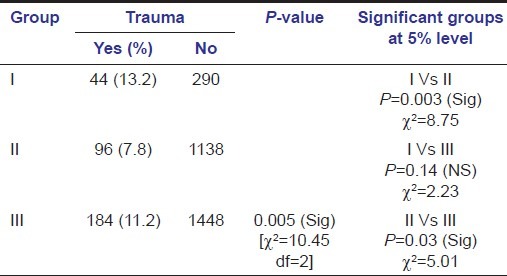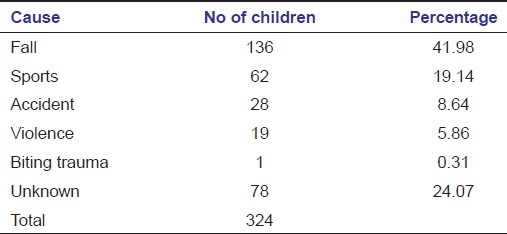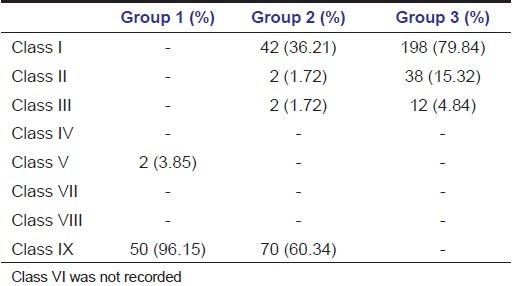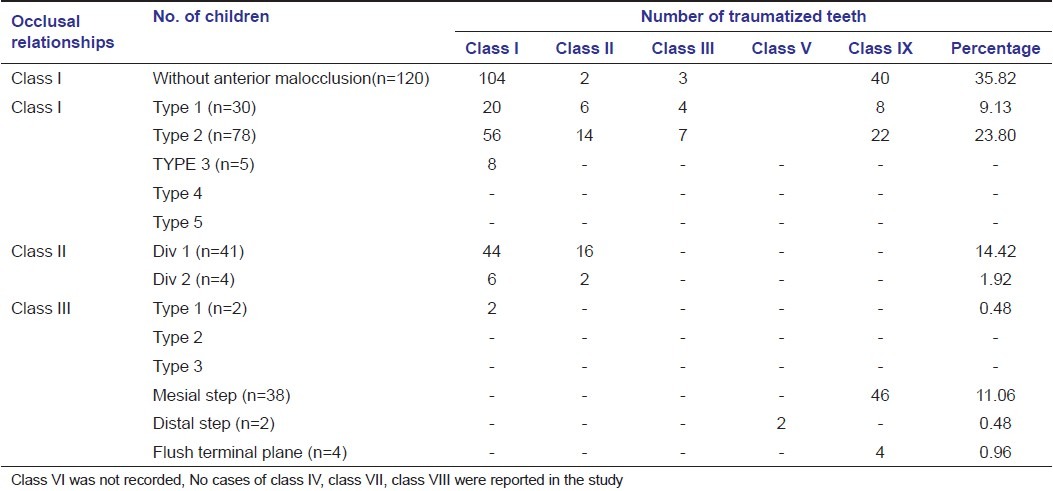Abstract
Context:
Dental trauma has become an important attribute of dental public health. The primary requisite before actively dealing with such problems is to describe the extent, distribution, and associated variables with the specific condition.
Aims:
The aim of the present study was to assess the prevalence and distribution of traumatic dental injuries (TDI) to anterior teeth among 3 to 13 years old Chidambaram school children.
Settings and Design:
A cross-sectional study was conducted. Data was collected through a survey form and clinical examination.
Materials and Methods:
A total of 3200 school children in the age group of 3-13 years were selected from 10 schools of Chidambaram, Tamilnadu. Information concerning sex, age, cause of trauma, number of injured teeth, type of the teeth, lip competence, terminal plane relationship and the molar relationship were recorded.
Statistical Analysis Used:
The statistical software EPIINFO (Version 6.0) was used for statistical analysis. In the present study, P≤0.05 was considered as the level of significance.
Results:
The trauma prevalence in the present study was 10.13%. Children with class I type 2 and mesial step molar relationship exhibited more number of dental injuries. Enamel fracture was the most common injury recorded. Only 3.37% of the children had undergone treatment.
Conclusion:
The high level of dental trauma and low percentage of children with trauma seeking treatment stresses the need for increased awareness in Chidambaram population.
Keywords: Anterior teeth, malocclusion, overjet, prevalence, trauma
Introduction
Dental trauma is a significant problem in young people and the incidence of trauma will exceed that of dental caries and periodontal disease.[1]
Among the earliest causes of traumatic dental injuries (TDI) are increased overjet with protrusion and inadequate lip coverage.[2] These oral injuries can cause irreparable dental loss, not only at the time of accident, but also during the post-treatment period.[3] It has been reported that the majority of dental injuries involve the anterior teeth.[4]
The aim of the present study was to determine the trauma prevalence, among school children in South India.
Materials and Methods
This study was conducted among 3200 school children aged 3-13 years from 10 schools of Chidambaram town, Tamilnadu.
Scheduling of the survey was done by sending a prior letter of notification regarding the date and time of examination of the school children. Necessary permission was obtained. Selection was done by simple random sampling.
Study sample was divided into three age groups as, Group I: 3 - 5 years; Group II: 6 - 9 years and Group III: 10 – 13 years.
Examination was done as per WHO type IV criteria. Ellis and Davey's (1960) classification was used for recording injuries. However, type VI injury was not recorded as dental radiographs were not available for diagnosis in the in-school field conditions.[5] The examination was carried out by a single trained dental surgeon.
Data was obtained concerning the prevelance of TDI, age, gender, etiology, type of fractured teeth, occlusal relationship - terminal plane relationship and the molar relationship (Angle's molar classification with Dewey's modification) and lip competence. In addition, the levels of unmet treatment needs were ascertained.
The clinical examination included a visual inspection for lip coverage as the subject entered the examination room without subjects’ awareness. Lip coverage was recorded as adequate if the lips covered the maxillary incisors in a rest position and as inadequate if the majority of the crown height was exposed.[6] The statistical software EPIINFO (Version 6.0) was used for statistical analysis. Proportions were estimated from the sample for each study group. Proportions were compared by Chi-square test with Yates correction / Fisher's exact test (z-tailed) approximately. In the present study, P≤0.05 was considered as the level of significance.
Results
Of the total 3200 children, 1890 were boys (59.06%) and 1310 were girls (40.94%). A total of 324 cases (10.13%) had TDI. Trauma was more prevalent among the boys, compared to the girls. A total of 416 injured teeth were identified, in which 122 were primary teeth and 294 were permanent teeth.
The level of traumatic injuries in boys (10.7%) was significantly higher than girls (9.3%) (P=0.02) and this was particularly true in group III (P=0.0002). [Table 1].
Table 1.
Comparison of proportion of trauma between boys and girls in different study groups

In the present study, proportion of trauma in Group I (13.2%) was significantly higher than group II (7.8%) (P=0.003). The gender difference was statistically nonsignificant in 3-5 years and 6-9 age groups. But group III boys (12.8%) show significantly higher level of trauma than girls. (9.1%) P=0.002. Also, the proportion of trauma in group III (11.2%) was significantly higher than group II (7.8%) (P=0.03). However, there was no significant difference in proportion of trauma between groups I and III (P=0.14). This study has also shown that the frequency of traumatic injuries to the anterior teeth increased with age, which was maximum at 10-13 years.[Table 2]
Table 2.
Comparison of proportion of trauma in different study group

TDI by falls (41.98%) was identified as major etiological factor followed by cases with unknown etiology (24.07%). [Table 3]
Table 3.
Cause-related distribution

Single tooth injuries were seen in 73.46% cases, 24.69% of cases had two teeth injuries and 1.85% of the subjects had injuries to three teeth.
In both the dentitions maxillary central and lateral incisors were the most commonly affected teeth and enamel fractures was the most common form of injury in the permanent dentition. [Table 4]
Table 4.
Classwise occurrence of the injuries

One hundred and twenty children with class I molar relationship without any anterior malocclusion showed 149 fractured teeth (35.82%). [Table 5]
Table 5.
Trauma distribution by type of occlusion

Among the group of children who had experienced trauma, 161 children (49.69%) had incompetent lips at rest, of which 9 (5.59%) children belonged to group I, 63 (39.13%) children belonged to group II and 89 (55.28%) children to group III, respectively.
Only 14 cases (3.37%) with traumatized teeth had undergone treatment
Discussion
This study identified a prevalence of 10.13% among children aged 3-13 years from 10 schools in Chidambaram, South India.
Higher numbers of TDI were recorded in 3-6 years and 10-13 years age group. This study has also shown that the frequency of TDI increased according to age, which was maximum in 10-13 year age group as reported in earlier studies.[5]
Although dental injuries occur at any age, they are more often seen between 2 and 5 years. During this developmental period, children learn to walk and then to run. Because their coordination and judgment are keenly developed, falls are common. As children gain confidence and coordination, the incidence of dental injuries decreases; it then rises again during the very active age range (8-12 years), as a result of bicycle, skateboard, playground and sports accidents.[5] Borssen E et al,[7] showed similar results that trauma occurred in higher levels at 4 yrs and then at 8-12 yrs.
More injuries were recorded in permanent dentition than primary dentition as reported previously by Rai et al.[5]
The finding that boys (10.7%) experienced dental trauma more frequently than the girls (9.3%), agrees with other similar studies from across the world.[1,5] The relatively low prevelance of trauma in girls can be explained by the fact that girls are generally more mature in their behavior than boys, who tend to be energetic and inclined toward vigorous outdoor activities.[1]
Falls were the main cause of injury in the present study as have been previously reported.[1] In the present study the second most common cause was of unknown origin. This was in accordance with Rai and Munshi.[5] The most probable cause for this could be that the present study was retrospective in nature and several children did not remember the origin of the dental trauma. It might also be explained by the high prevalence of slight injuries (enamel fractures) found in the present study, since trauma was slight, it was possible that some children and parents were not worried about it, as it happened, so that some of them did not remember the circumstances of the traumatic event, when they were interviewed.[8]
Ellis classification is a simplified classification and has been used in a previous study[5] for recording dental trauma and as we did not evaluate injuries to the alveolar socket and fractures of the jaws or laceration of the gingival or oral mucosa, we preferred to use this simple classification instead of Andreasen's classification. The most common type of injury noted was type I fracture. This was in accordance with earlier studies.[1,9]
Cases with class I molar relation without any malocclusion, class I div 2 and class II div 1 exhibited large number of traumatic injuries. A large number of children who sustained accidental damage to their maxillary incisors had increased overjet and incompetent lips at rest as reported in previous study.[5]
This could be due to the fact that lips cushion the impact of colliding materials with anterior teeth thus minimizing the possibility of a fracture. Also increased overjet means increased exposure of teeth which predisposes to trauma.
Only 3.37% of the cases of traumatized teeth had undergone treatment. This indicates a low level of awareness among the parents about the importance of treatment. Another reason could be that on suffering any injury, the people usually rush to a nearby medical practitioner or hospital where dentists are not available or else the fear of the dentist keep them away. Economical and social status of the patients also may be some other factors, due to which people do not seek immediate dental treatment.
Accordingly, educational programs need to be instituted emphasizing the ways of prevention of dental trauma and the benefits of seeking immediate treatment for conservation of avulsed and fractured teeth. Such programs should be directed at the community level as well as in the schools. Continuing educational programs about the latest technologies in the management of traumatized teeth should also be arranged for the dental and medical practitioners.
Acknowledgment
I sincerely wish to thank Dr Kalarani Mohan, Dr Syed Shaheed Ahamed, Dr Joby Peter, Dr Shameer and Dr N. Malarkodi for their assistance in the smooth completion of the study.
Footnotes
Source of Support: Nil.
Conflict of Interest: None declared.
References
- 1.Navabazam A, Farahani SS. Prevelance of traumatic injuries to maxillary permanent teeth in 9 to 14 year old school children in Yazd, Iran. Dent Traumatol. 2009;26:154–7. doi: 10.1111/j.1600-9657.2009.00861.x. [DOI] [PubMed] [Google Scholar]
- 2.Glendor U. Aetiology and risk factors related to traumatic dental injuries – a review of literature. Dent Traumatol. 2009;25:19–31. doi: 10.1111/j.1600-9657.2008.00694.x. [DOI] [PubMed] [Google Scholar]
- 3.Díaz JA, Bustos L, Brandt AC, Fernández BE. Dental injuries among children and adolescents aged 1-15 years attending to public hospital in Temuco, Chile. Dent Traumatol. 2010;26:254–61. doi: 10.1111/j.1600-9657.2010.00878.x. [DOI] [PubMed] [Google Scholar]
- 4.Caldas AF, Jr, Burgos ME. A retrospective study of traumatic dental injuries in a Brazilian dental trauma clinic. Dent Traumatol. 2001;17:250–3. doi: 10.1034/j.1600-9657.2001.170602.x. [DOI] [PubMed] [Google Scholar]
- 5.Rai S, Munshi AK. Traumatic injuries to the anterior teeth among south kanara school children – prevalence study. J Indian Soc Pedod Prev Dent. 1998;16:44–8. [PubMed] [Google Scholar]
- 6.Baldava P, Anup N. Traumatic dental injuries in an adolescent male population in India. J Contemp Dent Pract. 2007;8:35–42. [PubMed] [Google Scholar]
- 7.Borssen E, Holm AK. Traumatic dental injuries in a cohort of 16 year olds in northern Sweden. Endo Dent Traumatol. 1997;13:276–80. doi: 10.1111/j.1600-9657.1997.tb00055.x. [DOI] [PubMed] [Google Scholar]
- 8.Petti S, Tarsitani G. Traumatic injuries to anterior teeth in Italian schoolchildren: prevalence and risk factors. Endod Dent Traumatol. 1996;12:294–7. doi: 10.1111/j.1600-9657.1996.tb00530.x. [DOI] [PubMed] [Google Scholar]
- 9.Granville-Garcia AF, de Menezes VA, de Lira PI. Dental trauma and associated factors in Brazilian preschoolers. Dental Traumatology. 2006;22:318–22. doi: 10.1111/j.1600-9657.2005.00390.x. [DOI] [PubMed] [Google Scholar]


